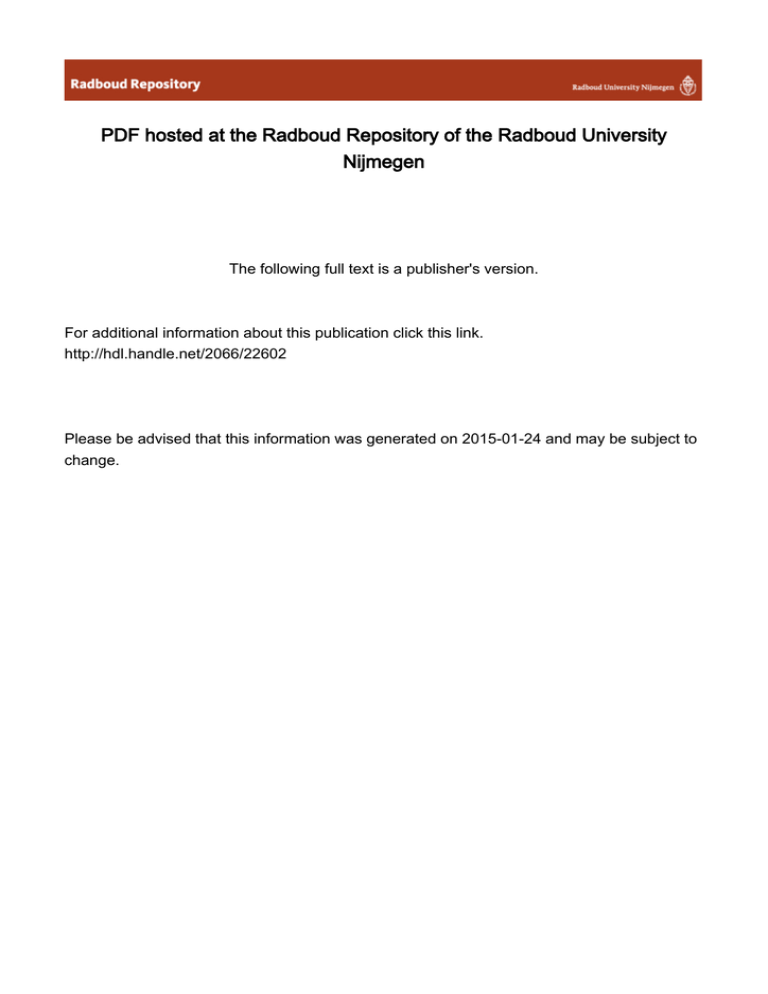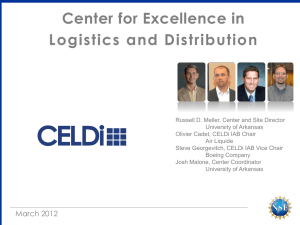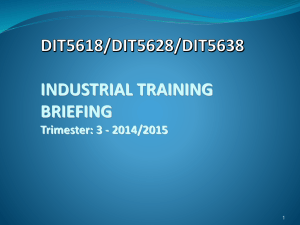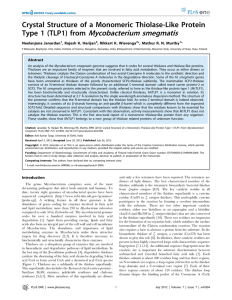
PDF hosted at the Radboud Repository of the Radboud University
Nijmegen
The following full text is a publisher's version.
For additional information about this publication click this link.
http://hdl.handle.net/2066/22602
Please be advised that this information was generated on 2015-01-24 and may be subject to
change.
ELSEVIER
Biochimica
et Biophysica Açta
Biochimica et Biophysica Acla 1315 (1996) 153-158
Non-rhizomelic and rhizomelic chondrodysplasia punctata within a
single complementation group
A.M. Motley ”, H.F. Tabak “•*, J.A.M. Smeitink c, B.T. Poll-The c, P.G. Barth h,
R.J.A. Wanders h
41 D epartm ent o f Biochemistry, E .C Slater institute, A ca d em ic Medical C enter , M eib er# d reefV t 1105 A Z Amsterdam, The Netherlands
b D epartm ent o f Pediatrics, A cadem ic M edical C enter M eih erg d reefV , I /0 5 A Z Am sterdam , The Netherlands
L W ilhehnina C hildren's H o sp ita l A B C Street, Utrecht , 'The N etherlands
Received 21 Septem ber 1995; accepted 3 N ovem ber 1995
Abstract
Several patients have been described recently who suffer from a non-rhizomelic type of chondrodysplasia punctata (CDP), but who
show all the biochemical abnormalities characteristic of the rhizomelic form of chondrodysplasia punctata (RCDP), a peroxisomal
disorder. We have used protease protection experiments and microinjection of repotter-protein-encoding expression plasmids to show that
peroxisomal thiolase fails to be imported into peroxisomes in cells from non-rhizomelic CDP patients, as has already been found in cells
from classical RCDP patients. Furthermore, complementation analysis after somatic cell fusion indicates that the non-rhizomelic CDP
patients are impaired in the same gene as classical RCDP patients. We conclude that defects in a single gene can give rise to both clinical
phenotypes.
Keywords: 3-ketoacyl-CoA thiolase; Disorder; Peroxisome; R hizom elic form of chondrodysplasia punctata; Fibroblast
m u in » in
1. Introduction
The rhizomelic form of
splasia punctata
(RCDP) is an
recessive
maractens
clinically by symmetrical shortening of the proximal ex­
tremities, congenital contractures, typical craniofacial dysmorphism with characteristic ocular involvement, severe
mental and growth retardation and typical radiological
abnormalities [1,2]. RCDP was assigned to the peroxiso­
mal disease category after finding an impaired plasmalogen (ether phospholipid) synthesis [3]. The biochemical
abnormalities in RCDP are now known to include (i) a
(partial) deficiency of dihydroxyacetonephosphate acyltransferase;
a deficiency of
•oxy acetone
phosphate synthase; (iii) an elevation of phytanic acid due
to the deficient «-oxidation of phytanic acid and (iv) the
presence of peroxisomal thiolase in precursor form .[2-~6].
Abbreviations: RCD P, rhizomelic form of chondrodysplasia punctata;
CDP, chondrodysplasia punctata; CAT, chloram phenicol aeetyltrunsfera.se
Corresponding author. Fax: + 3 1 20 6915519.
0 9 2 5 -4 4 3 9 /9 6 /$ 15.00 © 1996 Elsevier Science B.V. All rights reserved
SSD I 0 9 2 5 - 4 4 3 9 ( 9 5 ) 0 0 1 14-X
i m w i w iw i x w ifO in u
These deficiencies are likely to be the indirect result of a
defect in a single gene, the protein product of which may
be involved in the import of these enzymes into peroxi\s.
Although the above-mentioned subset of peroxisomal
j
ox isomes in RCD1
in
S IS
fibroblasts have been shown to be morphologically normal
and capable of importing ealalase [7] and peroxisomal
proteins containing the (C-terminal) peroxisome targeting
signal type I (PTS I) [8]. However, proteins containing the
type 2 peroxisome targeting signal (PTS2) (present in the
presequence of peroxisomal thiolase) are not imported into
peroxisomes in RCDP cells
Several patients have been described recently who show
chondrodysplasia punctata without the rhizomelic dwarfism
(non-rhizomelic CDP), but biochemically show all
peroxisomal deficiencies characteristic of RCDP [9-12]. It
ore
examine me
was
non-rhizomelic CDP patients and the
patients which we have earlier found to
classical
î 1nrire com plem entation trrour) i 13l. W e
fall into
have done this using complementation analysis following
A.M. Motley et al. / Bwchimica et Biophysica Acta 13 15 (1996) ¡5 3 -1 5 8
154
complementation group contains, in addition to the four
CDP
non-r
finine
somatic cell fusion. In this paper, we show that the four
non-rhizomelic CDP patients all belong to the same com­
plementation group as the classical RCDP patient. This
» *»V*sss;v;) ' s , a-'M .
/i
■ y.
V ^:
•* * *9.*•*'/
/ , »>. «
W a ?.
»• e :
* »*j
• >'<I:<?5
, *’'>' m m i's.y. J.' ',\
>%;►
*.*Uxt
1• r ?
V^ ;'.' '•i ■'.'S'*/:
W /M
rj:
'01; •: ' >■'
v»,s»•t , / ,
►
v*
y,"'
Ì< > » ;K
'<*'/ '. 1. .C;'.
1 ’'•’.:/,|:i;
w
/-:.1x*✓
■i. «iw
Vs,
i « •' >1 ?} '•
-i
•
•
;
x
^
. s'.
• ■ •I'.:f+
s y t . Li ^ • Y^'VV:: •f:’/ ,
: *»'^
**>':.
.
: V , ’• ' ' ’ ì V : '• y f ' / ' A ^ ^ ^ I c
.'V /
■W.ls
i* .'
'it;
^ fjyjf':’.: ^ ' •;v <V:•;v ’{! ;
.
ftv
■j)\: • 'j ' *
' '' ?.. i ' ^ k ‘ .■'• t
■J ' . '
V. ' :
' V/ / . VV' / 1
/fj ’;i *111''K i I
*8«
/
j s y y ^ . y ^ y / i > <*/ > i * r'*'
-
' v <:
y '• / <;' j I •’: ; i••. •
Y-VV Ì •^ ?Ì *• > [j >>!■
:j>
S; ; y i ' • < Ì :
; :i s '!•' v<
y^/X ih ) ryfo- W i r.v•"':^& vv ' >; <•V!¿v -VIv .'V:'
U'i rr.’;: ^ v /;: .-'v . ' t f W y A \
>,r
& W
.V \
vV >
V.!.*
:\ !
'• . • V v . T V '/ .
A»!1
'1i■•/I'Wjfh'fffJ
^
!■?/-,<i I
•
■■'.
: *. v \ i
• .*“,• •■'
• a• ^ i i
►
• ' * ¥ . ^•
V 's » * ; V •. •
■'■'.■i'/v < '
Ì •' '*•'
t V *1 •£/' A
j V•
.«J ?rX j
s;»*.»r.»\-VyUri.'fW.\
r>,
:
is' y.v ,,h! frr-X'•»W
■>; \ :
S
: : 'i ; " , v . ;
*
i f i ’- 'iU Xs':
* ' ‘ •.:
■>ò :
' '•.
1M
•?> .
•1 :1
7 v*'-
*v,|r: ;/>;•:ƒ
V-'.' ^ s'/'
’' ' J
1. ^1
-:•:> >
* •.. k >* ' V ; s
s>'>*
. : c : > ■:
i -
I I ' * ' «V.
A
! ';
* • •,l■}
■*i • ■
. V l : -'>': ; V - i «
•i.
►
. r - I ' / :■
>'
fefe^lÉSiÉMgSis
¡^'»'•VvVa C !'r^
? '*
'•'. • ' *»
'• ’/ ; / / .'; ' • »■; ■I • ►
►: *
5
f
:
;:
; '*
■, ■■ t .
,u
1 1 8 lll* llill^ ^ ^ ^ *
• ; J
/. • y. :
•r
«• '►. .S > . ' ^
' ' y
.'. 1 ' '. ^ '• ►*■** #
. L! s . ’ 1 \
■• ■? js -* •: : ' v ■■■/
> :.> > ■ ■■1'
'■
; : ■V
V/-
?»
'. ■\ s • ' • '►'.' 1 • • •
'■ . v '; : :
V
¡si
:v
fn s ilM
.»' ■. » # ►►
:
'/•.v V . • y,> : (,-' >: *..•
r i v v ; m --:•r , > .
: ^ ‘A
;■: V ,
'•• f-V *! ’• *■'» y . ‘ > •'.
*►'■ / •
'
» ’ >^ >*
'# M ÌI
= '• s' • s . V 1■ o - > :
*'•■ »■ • ;
‘ ■ ■ >> ..
•
^
V->-
** : •►'''
’* : ' '*»' j r*
/ : : .': ' ■
i '. /* • .. *
/■ \ i : > /v
i l
V / > '/
• ’.
» •
•‘ »*. »’. * *'► :
' .'■* : •' ' '. I
• *•
» : '• • ’.• '»' : V l 's r - ■ ^ V / . :.
►1. ►
• • *•
'.’• '’••V '• '
\
Ì ? T s ,> ^ ^ 5V^
' :’
A ' ’
:
-V ;:’.-:jv .-:• j ; / .;
••' • > S ’.
• *• . *
, <.'.•:Kw
: ) ;• MM-.-sv; rv ^. s •
'.'•’•'A />/'<•’', **J J ' y i - " r. •; *:
:V V.1'.'- ,'
.»:
•M
»
‘ . .»
' : ‘ i \ * v !• '> ■* •
ì ' ‘ ,, .
‘' ' * »
'■ : r’ ■. ? ? ■
w
Mi'.
r .y - . s r'.*; •
: •.
;.' I:;
' "''VV , '
,
'/,<•
;- ;^ v V V i.v
t e y - iu
i i x
■y.•> ■\V
11
^ r:.
i:
f
v > i->;.>':!<-j' ; >vV,'V rii”; i.V'>:
; \ W > • • '« '/ . I
'r
\y :> <
W P » aa>»;
r w- y r v
nv>
«»'i •»' : / / •
mSm’'m
m
!i >i^ vi-; ^Jij i ’>
?sc;
v ìv .m :.- !
.• r . - - I ; ; x , s s' .
: ««
> •'.-’r • • / . • : ; • : • i • <* ^
j
:Uv j
;
• / y y .‘
i ■y - ;
<r•
.' i, •/•».•/ / '«; 'V.:-;A
',*'
’’ • 'l
• *r ^ •,,
V ;v V > t y ir. •' ’ *•
.' '•’• • *' X',*': >:
, 1' '
: ; v 'i
• Cs’> ',\ ! '•>\ ! '' . 1
V. 'i ;
r ' l>(;
l' ' 0;ys,'>^
-f.
z.V'.V; ,'/, : !i >>V.:V-’/iv!
»;
v '.' »
•' i ' : ' /,> !
v 'r
i;
«; . ’ V■’ ','C »V ' . ’ >: ;<<j-' \ ;,; i •
,s ; ; > , '
: ‘ '1
I*-'' r •
'} ) • &
•V'
• : i s'
! •"' \ ‘ * **
y',\ '■
>s>' 1 '*
s >,', .
' '- >
/ ' ' *•
V'V'i'y
• •* *•
. <" i S t
:, v s' ! y t . , • •> :.V'’Vi
:v :
'*.'*' ►
' y ’•' '•
V ^ '/' -•' '■
v{:A:;
■rs ? ',<
•
•’«' ’ • <• ’
•, • ', ».
' '• ',,
T
*
(
/'•
►
•
^
^
/
s 'y - l f i M i • / V*•’ •: >
y.' y*.
'•i ' ^
*•
>1>*
■v ■■■/:
.'. » ».\ V/.' •/■V''. s"': i :
:V' ,' *•
, •»<"■/:* / v . ’ ».
00 • v • X
. ' :■Ì ;: M : - i s - l i . '' :>•,
• i,
.'.*>>: •. i • i.? ^ .' ►
,, '/•»'/: •
; L:’>yV «*’ '/
\ '1'
.• •• i9 >y .' '•■'*..'.
I ''X: ;V
* • .’ ►
’ v’
: !;’■;*/. * ì * ■'S ’
* vV \ ' ' ' y 'n : <•
* %; : •
•I
►
' '''.' i «* > • «■
. i ». .
' : •
1' *, /.
* /.;': ' i
r
i''*' «• *
1 .■'.'■.
*“•. ►
.: s.
''1
/ •*! »* •V''.'.' ^ '►
'i j y '. i
• i s '►■/
V: /;
; .'iy - '•'•'• *'s
1 •' •»:
.'s''•
y
.
*•"..
•
'
»
','. > *.r' i
.•». »v . / • *>« »• . 1v ^ • ; 1
i■
','® ',<
i/
.
.
■ r* -
<
.v \:
l-'Tr
I.N?.?*v:?>^!
••:•*.• 1 .• • • ; .' w . ' . y - s . '
• • ¡." ¡• • .r ^ s
:
.I;?.
vs
j
r v '- j : > I
-s ?•:-J 1 }U \l i
y. • > 'N V ' f •
• ••<•.%• i •j ». •/ i .'.v •■:•,-,• ••
:iilÉsWI
! C! Is r •
. 'S > \
vI
nrntmmM
5:5s ttv £ r ^V-.'Xx (viXAs
m m m m m m M m m im M M
y v ::.!i; 1 ‘' : :. v. '
' < : 1 ■■■
“ ■■■
>« ;> ■ :■
.
;
: ;' •;
;
;
^
'r :-'
•
: : ----,
■:.
f‘
I » ' . ■ » ■ .: '
a '
'• iA V .^ ‘■Vs* ■
j
-:
:' •-
. .
¿ " s : . ! • • . • • ’ . H n C J c f Ì A ^ 5 V / v ? •*
■ :: •
;y
;.■
• ; -• f f e Ì -
• :■:••;• . :' v= «-i d
■- ' S ;' ":".••"• Z
•*
‘4 :
'
s
;^
^
^
V ' 5 / • r * " V ^ '• V j ' - > •• -
*•* * V * :
Lt ; : ^
'•• v V-
• v
•
i'V; *v A . V-. ■
is
;
:
^L: i ' ^ f
. .*••
! .r v
/
:
: '',v
v*y
* i,
; i-.* j <
'
,
w
1x
' J 1 A*.J> < ■
• • • .'
• . i > i ’ * ’*•*•*:
.:
; ‘j* A
•
.:•*
" ' :
; :v " •■:.
.-*>.• , ;
,4>>
*• •
. i
t
t i
• *. *;
>
:.
; :: ' '
^
' a :'.V: ;.' :.v v . y
".*.* .*k* r !V * * ..« : : \ \ ^ ' . '
> **•
.
'" : v;;'.!.}...:: \ r ^
: ;■• :';.\r'.-:.:: ; : v ,: ^ ' ' 1.
******
: '
.
s. '
:
?
'* I* * A • •. .*
:7
*•'•**
mm
WSA
L V
V
4 P *: *.*
■ ■ '¡ ■ ■ ■ S '.- ; .
•I •
V
,: ' v w
•;
;.* .;*
;
V.
I- •
• • : - s •.< V
*. •* •*-.*• >
*• : • ;•
^ ’
. s .: '
: ; ••\ > 7 ! s /
v
. '-
'. .
' :.
..; • r .. . . .
. “ .**
^
; **. *<• • ' »
• ••.' :..
\
-
■
&
v
'.- ••••••.•
- ■• - - 'i-
!
')
•: s • Vr* >:
i
: ': , ; ; r v '
r i v ’f c : > ? . v '
: ^u>V / A fV
^
:
.
: < ; > ; ' < v %c / / V
:^ : : . !>*'} 1
^
i '.**.• *
> '♦ .•.
■
'
wrnimmgmmmm
, '^ : -
;
;
• ^
y
;:- v y
;m
&
m
\& •:^ \ . /
p
m
'
*
&
; r '
• *. >: : • ? . . .
-• ••;•
- . • ? ;r
1
v
'
.
-
v ! ' i
: • * .
*. •• : '-j
M
■.
:•*
■
,
V .
. ^
***
- ’• ; / * !
; : ';
!
*: i '
Kr > '
* ***** * *
.
^
:
v::-;:!:'-1:--.. : ■■:■■■■■:■■,■:,
: :
> :• !;?
;•* ‘ V •; =sv ^ ^ 0 ;.v* 1v•;*•' w
K 'f a - '/ f à :
!? V
> v > / / 0 . 1 ' ; * ^ ? S < - i : - * i / > *-*•:-•* » •.!•
^ ’■ '' ■ ^ v > r ^ | * : r
' . i - ; >*>*^ • - r - > -• *» s * ..* v
> ;
;
'
*
, .•■.
*./ k<*;-*
«*i ** . ' *!':•,:'••.••• I*,*.*- >.*>*i* •*'* 2<*-*. *.****\'v* *,*, *.*•*.*.*.•*:*.* '.*s . *>:•-• l i t i V >**» v - . v . i /••: •: \ • ^ ' ' :% * .* .. .* * * • . ' * ¡s' !
• 1*.'
*. V -
/ .
- ..
•. *.-:•<. $/£>. ; •' V•>; :
' Irv.-'O f.-> ;y. V;l' r .
Y / . \ V v /< > •;
,'••
:;
^
::.
'''.
s.:*V .-:.. r*; ¡i''/;* s,. v **'•
*:■ ' : : .'; / '/■<■'■<■' > V ’r { ' ^ \ y &
:■
.
•* .
il t.
i ^ • " -T * < '
^
• : : ^
V •* • / ‘ I ? • ; '
• .> • ;
< ^ .
;•• *• i! * - ’ • ^ * *. *. X ••
. V - * \ > • *V**. %* <s* -*l \
’V :• & y ji. :
V
•<•'
'
<of. <*Av.-;. ^ J .O.. / ; : ^ i / . - / v
^ V ' i ¿ 7 ;L
- * ,* 'v * « • ' * - * • *•-•>* •
,: Vi ;
::• •
': '
.
f - ,r ,v
> / ' ; •*ii•*:•*, : ^ : •*^' . 0 : !
*.*.*--
,
v < •*
V. . .
-
•
¿>*^ -•i
B ilÉ Iiii
******
...*
*..*.**' v : . '. * . 0 , w*. '. '/ . * : ' ! * O
i**. '! • - • ..•
Fig. I. Subcellular localisation o f the reporter proteins lueifera.se (A,B) and prethiolase-CAT (C,D) in
localisation of endogenous thiolase in control (E) and C D P 1 cells (F).
and CDP 1 (B,D) cells. Subcellular
155
sica Acta I J I 5 Í / W6 ) 15.1-/58
A.M. Motley et
2. Materials and methods
2.3. Cell fusion and assessment o f complementation
Fusion mediated by polyethylene glycol was carried out
. The fusion efficiency, defined as
exactly as
the percentage of total nuclei in multinucleate cells, was
always in the range 60-90% . The cells were processed for
immunofluorescence using a monoclonal anti-thiolase anti­
body 18 h after fusion. The appearance of particulate
thiolase using indirect immunofluorescence was taken to
2.1. Cell culture
Primary human skin fibroblasts were cultured in a 1:1
mixture of Dulbecco’s modified Eagle’s Medium and
Ham’s F10 (Gibco, Glasgow, UK) supplemented with 10%
foetal calf serum (Gibco) under 5% C 0 2. The fibroblast
lines used in the analysis were from a control
(85AD5035F), from an RCDP patient (cell line MCI-IE
85AD [13], from a Zellweger Syndrome
((GOM85AD) belonging to complementation
according to the Amsterdam nomenclature [15] and from
non
m
the literature [9-12] and one
(CDP4)
2.4. Proteinase K protection
*f\
in
, was
s were
cold PBS and resuspended to a protein concentration of
in isotonic sucrose buffer (250 mM
1
c
sucrose, 20 mM
125 jag/m l digitonin. The
(MOPS)) (pH 7.4) c
for 5 ruin at 37°C in digitonin
were
buffer. This concentration of digitonin
causes rupture of the plasma membrane, whereas the per­
oxisomal membrane remains intact. The protease protec­
tion assay (as described in [8] was carried out on ice using
a Proteinase K concentration of 40 /xg/m l in the presence
or absence of 0.5% Triton X-100. Samples were removed
after 0.5 and 1 h, and Proteinase K action was stopped by
addition of PMSF to 10 mM. Protection of thiolase was
a ik
f
2.2. Microiniection
24 h before microinjection the cells were plated onto
microinjection grids. The needles were made using a PB-7
micropipette puller (Narishage Co., Tokyo) and DNA was
injected in reverse PBS (4 mM N a 2H P 0 4/ l mM
KH2P 0 4/1 4 0 mM KC1 (pH 7.3)) at a concentration o f
approx. 0.1 m g /m l. 18 h after microinjection, the cells
were processed for immunofluorescence microscopy as
previously described [7]. The expression plasmid encoding
the PTS1 reporter protein firefly luciferase has been de­
scribed elsewhere [8]. The expression plasmid encoding
the PTS2 reporter protein, comprising the first 15 amino
acids of rat thiolase fused onto bacterial chloramphenicol
acetyltransferase (pRSV-FLT3~CAT), was a kind gift from
S. Subramani (University of California, San Diego, CA)
and is described by Swinkels et al. [14],
Proteinase K
-
Triton X-100
Time (min)
30 60
2.5. Immunoblot analysis
%IV*
to
Immunoblot analyses were performed as
+
30 60
+
W
+
■f
30 60
30 60
0
C
NALD
CDP1
41 kDa
*
— 41 kDa
Fig, 2. Accessibility o f endogenous precursor thiolase to digestion by proteinase K in permeahilised cells Irom a neonatal atlre
patient (upper panel) and C D P 1 cells (low er panel). C, lysate from control cells, showing 4 1 kDa mature thiolase.
kDa precursor thiolase migrates. Band m igrating above precursor thiolase is a cross-reacting band unrelated to thiolase.
at which 44
156
s k a Acta 1315 (1996) 1 5 3 -1 5 8
A M . Motley et al. / Biochimica el
(BioRad)) antibody
were performed in TBS containing 4% foetal
and 0.1% Tween 20. The blots were washed
after each incubation in TBS containing 0.1%
ing sites were blocked overnight with 10%
calf
serum in TBS (10 mM
(pH 8 )/1 5 0 mM NaCl)
containing 0.2% Tween 20. The primary (polyclonal anti
(goat anti-rabbit-conjugated
thiolase [16] and
incubations
calf serum
extensively
Tween 20.
iBlli
>S* 11
:V i
i-.l'
I:*;-
\-X£> y* \ .•.S.x:-1 .-i-N; •
•VV.’firi '•¿si !•: I*
WM%
0 *M:-S>V
•
.v
mm
I t i I-V
«'I
W
r.c'V'
»
i'.&y
• K' v.S.'j
Im
•
•
W x J /.iS
ivxr-*
•:'t'm
Wm"IVI.
iÉSM
;; l& W i ¡ilV
lifeii
w
w
m
m
k
fËÉiÉ
SyfctftëM .
m é
P M
mm
m
m
iH M É ttP iW
•MÈËêËêmÊêi$ÊêËBsmÊê
liÜIÜmmmmimm
10mm
\S•:^v i'/
i'oits »70;.:- v ^ '
S ' •’.■I iv .::
( • 't
<¡«1
*
.
^ ;>Vys::
•/r^,* •*/ JÏ .M
W.
.//
K 5:sj.vr::v.
x :/- ‘
;^.y. h;;/.ifcij.v :;•
j
1;-;..iv ;. s ' c j v
r
^y.yO/-1•i,':■.<•> >'s, \ •>.• <./. /1 <•
•
y.-A'ii;: :. :
’■jsVttj * i ;./ (
j1¿-i; v .;
■ W M ty iV -z
¡1!
Fig. 3. vSubcellular
C D P 1 X MCHE 85AD;
Cm
mm
M
*
; (E) CDP3 X M CHE 85AD; (F) CDP4 X M CHE 85AD.
I
A.M. Motley et al. / Biochìmica ci Biophysiea Actu ¡315 ( 1996) 153-158
axes were visualised using the ECL
kit from Amersham.
3. Results
Fibroblasts from each of the patients were tested for
their ability to import reporter proteins for the type 1 and 2
peroxisome targeting signals (Iuciferase and prethiolaseCAT, respectively) into their peroxisomes. A particulate
pattern of labelling was seen in control fibroblasts after
expression of both Iuciferase (Fig. 1A) and prethiolaseCAT (Fig. 1C); both these reporter proteins have previ­
ously been shown to co-localise with endogenous peroxi­
somal proteins [8]. The PTS1 reporter protein Iuciferase
has previously been shown to be imported into peroxi­
somes in RCDP cells [8].
s reporter protein is als
to peroxisomes in cell lines C D PI-4. Fig. IB
shows the expression pattern in CDP1 cells.
In contrast to the PTS1 reporter protein, expression of
the PTS2 reporter protein in CDPI cells gave rise to a
diffuse pattern of labelling resembling a cytoplasmic local­
isation (Fig. ID). Labelling patterns similar to the latter
were observed with cell lines CDP2-4 (not shown) and
have also been observed in cells derived from classical
RCDP patients [8], The labelling patterns seen after ex­
pression of prethiolase-CAT were similar to those seen
when endogenous thiolase was visualised using a mono­
clonal antibody (Fig. 1E,F).
Thiolase import was assessed further by determining the
accessibility of endogenous peroxisomal thiolase to pro­
tease digestion. Precursor thiolase is protected from pro­
tease digestion in fibroblasts from a neonatal
, upper pi
import of precursor thiolase has been shown to be intact
[8]. In all of the CDP patients (o f which CDPI is shown in
Fig. 2, lower panel), precursor thiolase is
by
K, presumably because of its failure to be
imported into peroxisomes.
The genetic relationship between the four CDP patients
and a classical RCDP patient was investigated by comple­
mentation analysis after somatic cell fusion of different
combinations of fibroblasts. As has been :
by Heikoop
et al. [13], the appearance of punctate fluorescence using a
monoclonal anti-thiolase antibody can be taken as a mor­
phological criterion to indicate complementation. When
fibroblasts from a Zellweger patient were fused with CDP I
fibroblasts, a punctate pattern of fluorescence was seen in
the heterokaryons (Fig. 3A). Similar results were obtai
after fusion of CDP2-4 with ZS cells (not shown). In
contrast to the fusions with ZS fibroblasts, no punctate
fluorescence could be observed when different, pairwise
combinations of fibroblasts from the CDP patients were
fused with each other, indicating that cell lines CDP 1-4 all
belong to the same complementation group. Fig. 3B shows
the labelling pattern 18 h after fusion of cell lines CDPI
and CDP2.
157
In order to investigate whether the CDP patients are
deficient in the same gene as that deficient in classical
RCDP patients, cell lines CDP 1-4 were each fused with a
representative cell line from the large complementation
group that contains fibroblasts from 9 classical RCDP
was seen i
patients [13]. No punctate
fusions between CDP and classical RCDP cell lines, indi­
ines are deficient in the same gene.
cating that all
s the pattern of labelling 18 h after pairFig. 3C
with a
wise fusion of
classical RCDP cell line (MCHE
4. Discussion
;tata patients
The non-i
shown to
in this study have previously
aracteristic of
the biochemical abnormalities
We have c
from a classical
patients to
non-rhizomclie
RCDP patient with respect to their ability to import the
PTS I-containing protein Iuciferase and the PTS2-containing protein thiolase. We have also investigated the genetic
relationship between non-rhizomelic CDP patients and a
classical RCDP patient using complementation analysis
after somatic cell fusion. Fibroblasts from the classical
RCDP patient have already been shown to belong to the
same complementation group as 8 other patients with the
clinical manifestations of RCDP [13].
The ability of CDP and RCDP cells to i
shows that the PTS1 import route is intact in these cells.
Analysis of (i) the subcellular localisation of a reporter
protein for the thiolase i
rescence and (ii) the i
degradation has shown
s to
m
that precursor thiolase in both RCDP and non-rhizomelic
CDP fibroblasts failed to be imported into peroxisomes.
We conclude from the above that the non-rhi;
patients cannot be distinguished from the classical RCDP
patient either with respect to their ability to import the
PTS 1-containing reporter protein Iuciferase, or with re
spect to their inability to import PTS2-containing peroxiso
mal thiolase.
It was therefore of interest to investigate
RCDP and the
rei at ion sh ip between
CDP patients. The failure of punctate thiolase labelling to
alions of non
after fusion of various
rhizomelic CDP fibroblasts and RCDP fibroblasts (in con­
trast to when Zellweger fibroblasts were used as a fusion
c
partner) indicates that the non-rhi/;
fibroblasts all belong to the same complementation group.
It is striking that defects within one and the same gene can
rise to both the rhizomelic and the non-rhizomelic
forms of CDP. It is possible that the mutations present in
non-rhizomelic CDP patients give rise to a protein
:t with higher residual activity than that found in the
<**
158
A.M. Motley et al. / Biochìmica et Biophysica A d a 1315 (1996) 1 5 3 - 1 5 8
more severe RCDP patients, as at least one of the CDP
patients [9] had higher DHAP-AT activity than that found
in RCDP patients. Support for this possibility is provided
by Wanders et al., who have described two patients [17,18]
who showed all the clinical features of RCDP but lacked
the tetrad of biochemical abnormalities usually found in
RCDP patients: in both patients, phytanic acid oxidation
was normal, and thiolase was present in its mature form
inside peroxisomes. However, both patients showed a defi­
ciency in plasmalogen biosynthesis: in one patient, the first
enzyme required for plasmalogen biosynthesis was defi­
cient (DHAP-AT) [17], while the other patient lacked only
the second enzyme [18]. These results strongly suggest that
the pathogenesis of RCDP is directly related to the inabil­
ity to synthesise plasmalogens [17,18].
The finding that patients suffering from non-rhizome!ic
and rhizomelic CDP have a deficiency in the same gene
indicates that the former is simply a milder form of the
latter. A complementation group which includes patients
suffering from the peroxisomal disorders Zellweger Syn­
drome, Infantile R efsum ’s disease and neonatal
adrenoleukodystrophy shows that phenotypic heterogeneity
within a single complementation group is not unprece­
dented [15,19-21],
References
[1] Lazarow, P.B. (1987) J. Inher. Metabol. Dis, 10, 1 1-22.
[2] Poulos, A., Sheffield, L., Sharp, D., Sherwood, G., Johnson, D.,
Beckman, K., Fellenberg, A.J., Wraith, J.E., Chow, C.W., Usher, S.
and Singh, H. (1988) J. Pediatr. 113, 685-690.
[3] Schutgens, R.B.H., Heymans, H.S.A., Wanders, R.J.A., Van den
Bosch, H. and Tager, J.M. (1986) Eur. J. Pediatr. 144, 430-440.
[4] Heymans, H.S.A., Oorthuijs, J.W .E., Nelck, G., Wanders, R.J.A.,
Dingemans, K.P. and Schutgens, R.B.H. (1985) New Engl. J. Med.
313, 187-188.
[5] Heymans, I-I.S.A., Oorthuijs, J.W .E., Nelck, G., Wanders, R.J.A.,
Dingemans, K.P. and Schutgens, R.B.H. (1986) J. Inher. Metabol,
Dis. 9. 329-331.
[6 ] Hoe tier, G., Hoel'ler, S. W atkins. P.A., Chen, W.W., Moser, A.,
Baldwin, V., McGillivary, B„ Charrow, J., Friedman, J.M .. Rut­
ledge, L., Hashimoto, T. and M oser, H.W. (1988) J. Pediatr. 112,
726-733.
[7] Heikoop, J.C., Vandenberg, M. Strijland, A., Weijers, P.J., Schut­
gens, R.B.H., Just, W.W., W anders, R.J.A. and Tager, J.M. (1991)
Biochim. Biophys. Acta 1097, 6 2 -7 0 .
[8 ] Motley, A.M., Hettema, E.H., Distel, B. and Tabak, H.F. (1994) J.
Cell Biol. 125, 7 5 5 -7 6 7 .
[9] Nuoffer, J.M ., Pfammatter, J.P., Spahr, H., Toplak, H., Wanders,
R.J.A., Schutgens, R.B.H. and Weismann, U.N. (1994) J. Inher.
Metab. Dis. 17, 6 0 -6 6 .
[10] Poll-The, B.T., Maroteaux, P., Narcy, C., Quetin, P., Guesnu, M.,
Wanders, R.J.A., Schutgens, R.B.H. and Saudubray, J.M. (1991) J.
Inher. Metabol. Dis. 14, 3 6 1 -3 6 3 .
[ I l l Smeitink, J.A.M., Beemer, F.A., Espeei. M., Donckcrwolckc,
R.A.M.G., Jakobs, C\, W anders, R.J.A,, Schutgens, R.B.H., R ods,
F„ Duran, M., Dorland, L„ Berger, R. and Poll-The, B.T. (1992) J,
Inher. Metabol. Dis. 15, 377-380.
[12] Pike, M.G., Applegarth, D.A., Dunn, H.G., Bamf'orth, S.J., Tingle,
A.J., W ood, B.J., Dimmick, J.E., Harris, H., Chantler, J.K. and Hall,
J.G. (1990) J. Pediatr. 116, 8 8 -9 4 .
[13] Heikoop, J.C., W anders, R.J.A., Strijland, A., Purvis, R., Schutgens,
R.B.H. and Tager, J.M . (1992) Hum. Genet. 89, 439-444.
[14] Swinkels, B.W., Gould, S J . Bodnar, A.G., Rachubinski, R.A. and
Subramani, S. (1991) EM BO J. 10, 3255-3262.
[15] Brul, S., W esterveld, A. Strijland, A., Wanders, R.J.A., Schram,
A.W., Heymans, H.S.A., Schutgens, R.B.H., Van den Bosch, H. and
Tager, J.M. (1988) J. Clin. Invest, 81. 1710-1715.
[16] Heikoop, J.C., Ossendorp, B.C., Wanders, R.J.A., Wirtz, K.W.A.
and Tager, J.M. (1992) FEBS Lett. 299, 201-204.
[17] Wanders, R.J.A., Schumacher, H„ Heikoop, J., Schutgens, R.B.H.
and Tager, J.M. (1994) J. Inher. Metabol. Dis. 17, 315-318.
[18] Wanders, R.J.A., Dekker, C., Horvath, A., Schutgens, R.B.H., Tager,
J.M., Van Laer, P. and Lecoutere, D.
J. Inher. Mclahol. Dis,
15, 3 8 9 -3 9 1 .
[19] Roscher, A.A., Hoel'ler, S., Hoel'ler, G., Paschke, E., Paltauf, II,
Moser, A. and Moser, I-I.
Pediatr. Res. 26, 6 7 -7 2 .
[20] Sliimozawa, N., Suzuki, Y., Orii, T., Moser, A., Moser, H. and
Wanders, R.J.A.
Am. J. Hum. Genet. 52, 843-*844.
[21] Yajima, S., Suzuki, Y., Shiniozawa, N„ Yamaguchi, S., Orii, T,,
Fujiki, Y., Ostimi, T., Hashimoto, T. and Moser, H.W. (1992) Hum.
Genet. 88 , 491-499.










